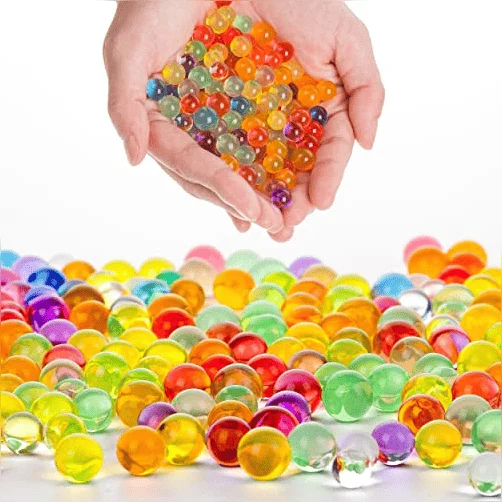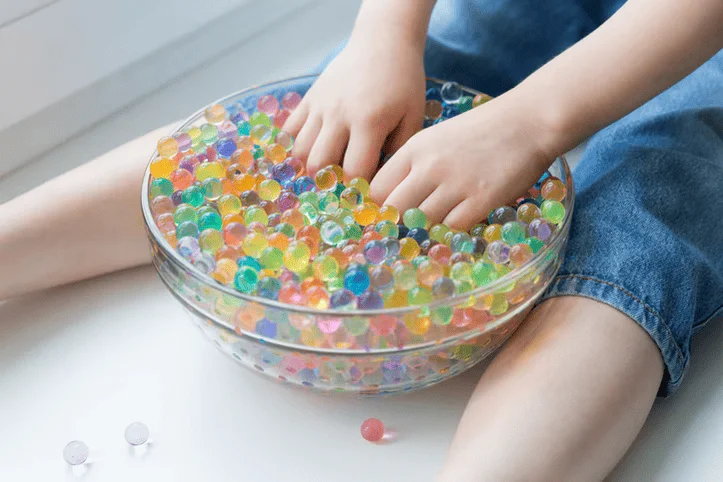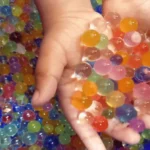Water beads have been popular for years, often used in both sensory play and home décor. They’re small, colorful, and fascinating to watch as they absorb water and grow in size. Kids love them, but these seemingly harmless beads come with significant risks, especially when marketed to children. In response to increasing safety concerns, many major retailers have announced they will stop selling water beads targeted at kids. This move is part of a broader effort to protect children from potentially dangerous products.
In this blog, we’ll dive into why water beads are being discontinued for kids, the risks involved, and what parents need to know about keeping their children safe.
Table of Contents
1. What Are Water Beads and Why Are They Popular?
Water beads, also known as sensory beads or gel beads, are tiny, colorful beads made of super-absorbent polymers. When dry, they are small, but when soaked in water, they grow into soft, squishy balls. Originally, water beads were designed for decorative purposes—used in flower arrangements or as vase fillers—but they quickly found a second life as a popular sensory play tool for children.
Kids are drawn to the tactile nature of water beads. They’re soft, bouncy, and engaging, making them great for sensory bins or therapeutic activities. They’re often marketed as a fun way for children to engage in hands-on, creative play. However, the very features that make water beads fun can also make them dangerous when not handled properly, especially around young children.

2. The Risks Associated with Water Beads
While water beads seem harmless, they pose significant safety risks, particularly for younger children. One of the main dangers is the possibility of accidental ingestion. Since water beads start out small and expand when exposed to water, they can be easily swallowed by children who may mistake them for candy or another edible item. Once ingested, the beads can grow in size inside the body, leading to serious medical issues like intestinal blockages.
Some of the key risks of water beads include:
- Choking Hazards: If children try to swallow water beads, there is a risk of choking, especially before the beads have expanded in size.
- Ingestion Risks: Once swallowed, water beads can absorb fluids in the digestive system and swell, potentially causing blockages in the intestines or stomach.
- Swelling Hazards: Even if not swallowed, water beads can pose a danger when they expand too much inside a child’s nose, ears, or other body cavities.
- Injury Reports: Numerous reports of injuries related to water beads have surfaced in recent years, leading to increasing concerns among parents and safety organizations.
3. Why Retailers Are Discontinuing Water Beads for Kids
As awareness of the potential dangers of water beads has grown, retailers have started to take action. Many major retailers, including those who once marketed these products specifically for children, are now halting sales. The decision to discontinue water beads targeted at kids follows growing pressure from consumers, safety advocacy groups, and medical professionals.
Key reasons for the discontinuation include:
- Consumer Advocacy: Parent groups and consumer safety organizations have raised awareness about the risks associated with water beads, particularly for younger children. They’ve called for more stringent safety regulations and better labeling of products.
- Safety Concerns: Increasing numbers of injury reports have led retailers to rethink their product lines. The potential for serious harm, including choking and blockages, has prompted them to take proactive measures.
- Product Recalls: In some cases, water beads have been recalled due to safety risks. These recalls often serve as a wake-up call for retailers, encouraging them to discontinue similar products before more harm occurs.
Retailers are recognizing their responsibility to ensure the safety of the products they sell, especially when children are involved. By pulling water beads from their shelves, they’re taking an important step toward reducing the risk of injury.
4. Official Responses and Statements
Many retailers have publicly addressed their decision to stop selling water beads targeted at children. Some have issued formal statements, explaining that their primary concern is customer safety, particularly for their younger shoppers.
For example, large chain stores have noted that they are reevaluating their product lines in response to safety concerns. While some have opted to discontinue water beads entirely, others are pulling only the children-targeted versions, continuing to sell beads marketed for adult use, such as for decoration or gardening.
Consumer safety organizations, such as the Consumer Product Safety Commission (CPSC), have also weighed in on the issue. They have issued warnings to parents and caregivers about the dangers of water beads and encouraged retailers to take action. Some health professionals and child safety advocates have similarly praised these moves, citing them as necessary to prevent further injuries.
5. What Parents Should Know About Water Beads
If you have water beads at home or are considering using them for sensory play, there are important safety precautions you should take to protect your children. Here’s what parents should keep in mind:
- Keep Water Beads Out of Reach: If you already own water beads, make sure they are stored in a place where small children cannot access them. Supervision is essential during playtime.
- Supervise Playtime: If your child uses water beads for sensory play, ensure they are old enough to understand the risks and that play is closely monitored. Always be present to ensure beads aren’t being ingested or placed in ears, noses, or other dangerous locations.
- Opt for Safer Alternatives: There are many safe alternatives for sensory play that don’t carry the same risks as water beads. For example, playdough, kinetic sand, or slime are safer options that offer similar tactile experiences.
- Discard Water Beads After Use: If you decide to use water beads, dispose of them properly after playtime. Don’t leave them lying around, as they can quickly become a choking hazard for pets and children alike.
Parents should stay informed about product safety and always check for any recalls or warnings regarding toys or products intended for their children.
6. The Impact on the Market
As more retailers stop selling water beads targeted at children, there may be broader implications for the market. Manufacturers may begin to shift away from producing these products for children and instead focus on decorative or non-child-related uses.
This move may also push the toy industry toward creating safer, more carefully regulated sensory play products. Manufacturers may start investing in new alternatives that still provide the same sensory benefits without the associated risks. The growing demand for child-safe products could lead to innovation in this area, with new products emerging that are designed with safety as the top priority.
While water beads won’t disappear entirely from the market, their availability for children’s play may become limited, as parents seek safer options and retailers focus on providing better alternatives.
7. Conclusion
The decision by major retailers to discontinue water beads marketed toward children is an important step in ensuring child safety. While these beads are fun and engaging, their risks—especially when ingested—are too significant to ignore. By pulling these products from shelves, retailers are responding to the concerns of parents and safety advocates.
For parents, the best course of action is to stay vigilant and prioritize safety when it comes to choosing toys and sensory play items. There are plenty of safer alternatives available that can still provide enriching, hands-on play without the same level of risk. As always, staying informed and cautious can help ensure a safe, enjoyable playtime experience for your kids.

Jessica Muller is an accomplished writer at Water Beads Design, holding a Bachelor’s degree in Fine Arts with a focus on Design and Visual Communication. Her expertise in water bead artistry is backed by over 5 years of experience in the field, where she has developed a deep understanding of artistic techniques and design trends. Jessica’s writing reflects her extensive knowledge and creative approach to water bead design. For professional tips and innovative ideas, follow Jessica on Instagram.





